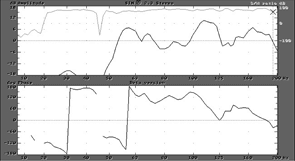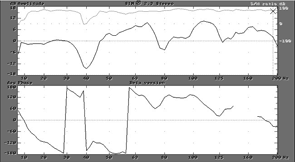Speaker Placement and Acoustic Environment Effects
on Nearfield Monitor Systems –
MIX Magazine
To Woof Or Not To Woof? A SUBstantial Question – MIX Magazine
Optimizing the Studio Listening Environment – MIX Magazine
Acoustic Solutions, The RPG B.A.S.S. Trap – MIX Magazine
Examining the Yamaha NS-10M “Tissue Paper Phenomenon” – Recording Engineer/Producer Magazine
Educational Resources
Articles written either for MIX
Magazine or Recording Engineer/
Producer Magazine.
– by Bob Hodas
Gain insights into studio listening environments and rooms.
To Woof Or Not To Woof? A SUBstantial Question
MIX Magazine, June 1997 – by Bob Hodas
A number of my room tuning clients have asked me if they should add subwoofers to their main system. There are three reasons for this trend. One is the problem of the increasingly loud listening levels that some clients tend to work at. Second is low end loss when a system designed for soffit mounting is placed in free space. Finally there is the need to hear more deep bass when working on small close or mid field monitors. If your studio falls into one of these categories, read on. Let's address the issue of volume first.
Many of my studio clients are complaining that the Rap projects are destroying their main monitors. The Rappers like to turn up the speaker systems until the bass is making their pantlegs flap. Of course the studio speakers were not designed to operate at concert volumes. When a bass driver blows up, it can cost almost two hundred dollars to recone. Multiply that by four fifteen inch woofers, and more often than not, the tweeters go first! I just finished tuning a room at Platinum Island in New York where a client is destroying the monitors every three or four days. He has gone through twenty sets of drivers since the project started. This is just crazy and the engineers should know by now that the drivers will blow up at certain volumes.The issue is that these clients are listening at unreasonable volumes. But a studio owner cannot tell his client how loud to listen. Putting a compressor on the system does not help because the clients complain when they hear it working. The simple solution is to add a subwoofer to the system. This can take a lot of the pressure off of the main woofers and give the clients enough bass volume so that they do not have to push the whole system so hard. The initial cost to the studio may seem high but they can save money over time. Based on the cost of replacing speakers so often, even the most expensive subwoofer system can pay for itself within a year. This is especially true considering the cost of the engineers who must change the components. Most technicians have better things to do than change drivers.
For volume problems, I have been successful using the ELF subwoofer system made by Bag End. This system has a lot of versatility in size and set up options. It was developed by Ed Long who gave us the PZM, the first nearfield speakers, and the concept of time alignment. The Bag End subwoofers come in several speaker sizes with single or double speaker cabinets. I must tell you that these boxes are extremely compact because they utilize the principles of active electronics to achieve super extended low end down to 8Hz. They have self powered or stand alone versions.
When integrating a subwoofer, you want to set the crossover point so that you take some of the strain off the main system woofers. I usually like to set a crossover point at about 80Hz. This may vary a bit from system to system, depending on speaker location, main system low end response, and room size. By sending everything below 80Hz to the subwoofer, you can relieve the main system from having to produce the deep rumbling bass that the Rappers like. These are also the frequencies that can destroy your woofers. You also leave the bass and kick drum punch at 100-125Hz in the main system so that it feels connected to the upper and mid bass.
Remember that it is very important to provide the subwoofer with an amplifier that has plenty of power. Headroom is important since transient distortion can destroy your speakers. Adding a subwoofer gives you the added advantage of working the main system amplifier easier as well. You should experience less distortion and clipping overall.
I will tune a room with a subwoofer so that the system is accurate for clients that operate at reasonable volumes. Then I tell the studio owner to give the abusive clients a pot so that they can set the subs at whatever level they desire. It's not about accuracy at that point, it's strictly about volume.


Enlarge view
Figure/Chart 1 & 2 show a before and after shot of a Urei 813 soffit mounted in a room. All charts are 48th octave resolution shot with a Meyer SIM 3 System. In the upper chart, the trace along the top shows coherence while the middle trace is frequency response. The bottom chart shows phase. Figure 1 shows a severe rolloff at about 53Hz. Note the bass extension that is capable when a subwoofer is added in figure 2. You can see in the figure 2 phase chart that the subwoofer polarity and position is properly oriented since it integrates perfectly with the phase of figure 1. Phase integration of the subwoofer is very important at the crossover.
Figure/Chart 3 & 4 show a different room with the same setup (charts are frequency only). An interesting note is that even with the subwoofer, the same room response anomalies exist at 32Hz, 90Hz, and 135Hz. You may be able to correct some of these problems if there is enough space to move the subwoofer around in the room to establish an idealized location. Just don't expect your room problems to be solved by adding a subwoofer.
Reason number two. Certain monitors were designed to be mounted into wall soffits. The design of these speakers rely on a baffle to reinforce the low end. These speakers, the Urei 813 for example, exhibit a severe bass rolloff when mounted on stands with no walls surrounding them. If mounted in free space, these types of speakers can only function properly with the addition of a subwoofer to the system. If I were to equalize the system to make up for the low end loss caused by improper installation, too much strain would be placed on the woofers. Here we should raise the crossover point so that the subwoofer integrates with the natural rolloff of the main system. As an example, the 813 starts to rolloff at 125Hz in free space. It is necessary to set the crossover that high in order to get the proper response and power out of the system. Figures/Charts 5 & 6 demonstrate how well a subwoofer fills in the response.
Stereo Subwoofers
I am a very firm believer in stereo subwoofers. It is a common misconception that we cannot hear bass directionality. People often say that bass is omnidirectional and subwoofer room position is not important. I believe this misconception developed because of the way bass is treated when cutting lacquer masters for records. Frequencies below 200Hz are combined to mono in case there is any low frequency phase problems. Out of phase bass would make the lathe cutting head jump off the lacquer. So for many years we never had a chance to hear stereo bass. With the digital age this is no longer a problem. You can experiment by placing your subwoofer off to one side and see if you can hear its location. I'm sure you will. If you only use a mono subwoofer then it is very important that you place the subwoofer symmetrically between your speakers. Placing the subwoofer off to one side or the other will cause a non-symmetrical response in the left and right speakers at the crossover point. This is based on the uneven distance of the left/right speakers to subwoofer and will require more equalization to balance the system.


Enlarge view
For clients with close field monitors, the subwoofer application is quite different. The issue is not about power but about the ability to hear low frequencies that may make their recordings sound unclear and too bassy (Figure/Chart 7 & 8). Some of the more popular expensive small monitors extend down to 40Hz which is sufficient in many cases. But there are quite a few systems on the market with limited bass response. Adding subwoofers to these systems can save having to do major surgery to your mix in the mastering stage. Film and television composers need to hear the low bass frequencies in order to get their music right as well. Once again, if space is not a limitation, stereo subwoofers is the best way to go. Along with the ELF systems mentioned earlier, I have tuned a number rooms with the self powered Genelec subwoofer systems. The Genelec's have a switch that allows adjustment of the phase at 90/180/270 degrees. This has come in handy when there is limited space in which to move the subwoofer in relation to the mains. While the bass is not as extended, nor the options as versatile as the Bag End, I have had good success with Genelec in film composer's studios. Both systems can operate in mono or stereo for the subwoofer. Genelec's advantage is that it has a left/center/right crossover with mono summing for those who need to do film work.
Placement of any subwoofer system requires a good analyzer and someone who knows how to use it. Although the subwoofer manufacturers set up suggestions utilizing tones are valid, the results are crude and I have not seen a room that set up their subs properly without analysis. I personally use a SIM 3 System which allows me to see a 48th octave resolution linear display of both phase and frequency in real time. This gives me fast, accurate results. You want to achieve a linear phase response at the crossover point in order to get the best frequency response. An analyzer that displays phase is a must for this process. The process can be time consuming and requires trying placement in multiple locations and phase switch adjustments. Sometimes best results are achieved raising the sub off the ground, turning it upside-down, or even backwards. Moving a subwoofer a mere six inches to a foot can make a significant difference. If there is a rule of thumb, I haven't found it yet. Although this was a simplified look, I hope this article has helped fill in some blanks for you.





